An introductory note from Slarek.
That this is not a review aimed at newcomers to The Texas Chain Saw Massacre,
but a personal reflection on what it is that so thrilled me about the film,
both when I was first exposed to it back in the late 1970s and how it continues to astonish even today. In order to do this I've chosen to explore the film on a scene-by-scene basis, which means that the review is absolutely littered with spoilers, and even includes details of how the film ends. Thus if you've not seen the film and intend one day to do so, I'd hop forward to the disc coverage by clicking here.
| Blood brothers |
| Just a few of the reasons why I still regard The Texas Chain Saw Massacre as one of the greatest, most ground-breaking horror films in the long history of the genre, by Slarek |
|
| |
"It's a film about meat, about people who are gone beyond dealing with animal meat and rats and dogs and cats. Crazy retarded people going beyond the line between animal and human." |
| |
Director Tobe Hooper |
| |
"But the point is, if you put a little kid of six in the front row at a screening of The Texas Chain Saw Massacre along with an adult who was temporarily unable to distinguish between make-believe and "real things" (as Danny Torrance, the little boy in The Shining puts it) – if, for instance, you had given the adult a hit of Yellow Sunshine LSD about two hours before the movie started – my guess is that the kid would have maybe a week's worth of bad dreams. The adult might spend a year or so in a rubber room, writing home with Crayolas." |
| |
Stephen King – Danse Macabre |
It is, I would suggest, nigh-on impossible for a modern audience to appreciate the impact Tobe Hooper's seminal low budget horror favourite The Texas Chain Saw Massacre made on its release back in 1974. Like The Exorcist before it, the film came out of nowhere, not as the latest work in a developing sub-genre. There was nothing you could watch to prepare you for what you were about to sit through. It was a shock to the senses, a cinematic gut-punch that left audiences reeling and that upset self-appointed arbiters of morals and taste in just about every country on which it was unleashed.
Its first UK screening was at the 19th London Film Festival, where it became the subject of argumentative discussion between the audience and a trio of critics who went on stage to defend the film, including Nigel Andrews of The Financial Times,* but was still named by the festival as 'Outstanding Film of the Year'. The British censors were not so impressed. James Ferman, the then newly appointed secretary of the BBFC, is reported to have said after LFF screening, "It's all right for you middle-class cineastes to see this film, but what would happen if a factory worker in Manchester happened to see it?"** Heaven forbid. To protect these easily influenced working-class minds, the BBFC refused to grant the film a UK release. In an unusual exception, it was cut by approximately 30 seconds and granted a London-only release by the Greater London Council with what came to be known as a GLC-X certificate. Presumably working class Londoners were seen as being more resilient than their counterparts elsewhere back in the 1970s.

I was too young to legally see the film on its initial release, and although I was by then quite used to making myself look older and bluffing my way in to X-certificate films, the thought of travelling up to London to do so and being successfully challenged on unfamiliar turf required considerably larger gonads than I possessed at the time. About three years later I'd got into film school, and every couple of weeks would travel up to the capital to see as many movies as I could before the last train back to Bournemouth (I'd usually reach my bedsit at about 3am). One of first films I hunted out was The Texas Chain Saw Massacre, which was still playing at a number of cinemas around the city. I remember two things distinctly about that screening. First, that the cinema – whose name I cannot remember – actually had seats located behind sizeable pillars from which you couldn't actually see the screen. Brilliant. Secondly, the film itself scared the living shit out of me. Even three years on there'd been nothing to adequately prepare me for this. And right now, from a modern viewpoint, after exposure to all of the films it helped shape and that have looked to take the genre to greater extremes, you really can't hope to imagine just what it felt like to see The Texas Chain Saw Massacre for the first time back in the mid-to-late 70s. I'd give almost anything to experience such cinematic freshness and terror today.
I wasn't alone. Here are a couple of snippets from reviews of the time that capture the effect the film had on a contemporary audience:
| "The Texas Chain Saw Massacre made me feel trapped in a nightmare with my eyes open, running in glue trussed like a live lobster poised over the pot." |
| "All the strands come together, like purse strings around the throat. The film appears to gloat, to guffaw in hysteria, pushing its logic to lengths which would make Hitchcock, or even Polanski, pale and turn back. Sensationalism triumphs, and how, but with a consummate artistry the film-lover cannot help salute." |
Alan Brien, The Sunday Times, 21st November 1976 |
| "One of the damnedest films ever made. I'm sorry someone felt compelled to make it, but as long as they did, Hooper did an excellent job. The violence itself is not extreme, but the tension, atmosphere and thrills are extremely powerful." |
Bill Warren, Cinefantastique 3, no. 4 (Winter 1974/5) |
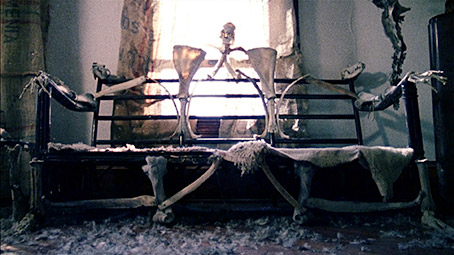
Some of you, looking back at the film from a modern perspective, will doubtless find such a reaction bemusing. I guess you had to be there. Films in which teenagers wander off the beaten track and find themselves in a living nightmare may be two-a-penny now, but for the vast majority of cinemagoers back in 1974 this was terrifying new ground. And this was a film that encouraged us to be nervous from the moment the lights went down.
First up there was the title. Forget all the slasher and torture porn titles you've heard since and try to imagine a time when mainstream American film titles were subtle or suggestive or even a tad unclear, ones such as Chinatown, The Conversation, The Parallax View, The Sugarland Express, Juggernaut or Thunderbolt and Lightfoot. The nearest the year's big movies came to shouting out their content were literary adaptations like The Three Musketeers and Murder on the Orient Express, or disaster movies like Earthquake or The Towering Inferno. Even horror movies were playing the subtlety game to keep you guessing about the content and the direction that the plot might take, with titles like Black Christmas, It's Alive, The Wicker Man and Peter Weir's intriguingly titled The Cars That Ate Paris. But The Texas Chain Saw Massacre? This tells you what's going to happen even before you enter the cinema, and that it's going to be very, very bad. The characters aren't going to be menaced but slaughtered. And with a chain saw. It's not a matter for conjecture. And you don't use a word like massacre if only one of them is going to die. This is a film that wanted us to fear what it assures us we're going to witness.
Even if you somehow fell into the cinema without realising what you'd bought a ticket for, the film wastes no time in bringing the point home, opening on a soberly read prologue that talks of the '"tragedy that befell a group of five youngsters" and that concludes, "had they lived very, very long lives they could not have expected, nor would they have wished, so see as much of the mad and the macabre as they were to see that day." Bloody hell. We've not even met them yet and already there's a sizeable pall hanging over their heads.
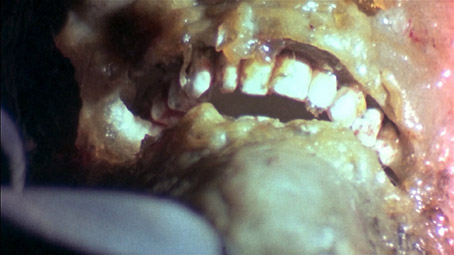
And then there's the first scene, which remains to this day one of the boldest and most strangely disturbing in horror film history. A pitch-black screen is accompanied by the non-specific but troubling sounds. Digging. Breaking. Breathing. Crunching. Rising underneath is a music score that I have no trouble classifying as experimental, a mix of strange off-key drones and random cymbals which every few seconds breaks into a pitch-shifting whine as a flashbulb is fired and we momentarily catch a glimpse of something. Something bad. Something monstrous. Body parts. Decay. It takes a while to register that what we are witnessing is a grave desecration. Maybe we never do, I can't really remember. As a news report talks about grave-robbing in Texas, we get our first glimpse of daylight and it's not a comforting one, a claustrophobically close shot of the face of a still-decaying corpse, which pulls back, in the first of the film's many gorgeously executed camera movements, to reveal what the newscaster dubs "a grisly work of art." He could have been talking about the film itself. The score rises up and the titles play over lithographic scientific footage of sunspots. As horror fans, we know this opening so well know that it's only when you take a step back that you realise that co-writer and director Tobe Hooper begins one of the greatest exploitation films of the modern age with an audio-visual experience that borders on the avant-garde. What balls. And this, dear readers, is why back in the late 70s, this particular audience member was twitching nervously before the story itself had even got under way.
In some ways setting the tone for the film that follows, our introduction to the young protagonists is offbeat to say the least. First framed behind a dead armadillo lying upside-down in the road, a camper van pulls up and ramps are placed in its side doorway to allow the paraplegic Franklin to disembark and position himself away from the road to take a leak. He's in the process of doing so when a lorry thunders past and creates a tailwind that blows him down the side of the grass verge and onto the ground below. Fortunately he is uninjured, and as he and his companions drive away there is talk of sunspots and Saturn being in retrograde, horoscope tomfoolery that just this once may be a warning about the dark direction the day will later take for this vehicle's occupants.
They are, it turns out, on their way to the exact Texas graveyard of the pre-title sequence, and their reason for travelling there proves sound enough. This is where the grandfather of two of the group, Franklin and his sister Sally, is buried, and they have driven cross country – in the company of their friends Jerry, Kirk and Pam – to reassure themselves (and, we can presume, their families) that his grave was not one of the ones that has been so rudely disturbed. Their arrival at the graveyard is strikingly naturalistic in tone, as they are greeted and assisted – somewhat pushily in the shape of the cowboy-dressed hulk who takes Sally's arm and tells her friends, "Hey, you don't mind if I steal your girl here" – by locals that all feel like the real deal rather than professional actors.*** Only Franklin is around to catch the portentous words of the drunk who, photographed ultra-wide and in a manner that positions him almost upside-down in frame, says to no-one in particular, "Things happen here about, they don't tell about. I see things. You see, they say that it's just an old man talking. You laugh at an old man. There's them that laughs and knows better."
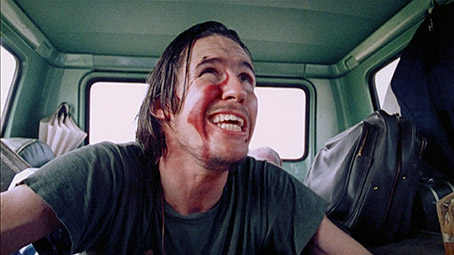
It's shortly after this that they pick up the Hitchhiker. He may not have a name, but he certainly makes one hell of an impression. Scarred by a large facial birthmark and just a little too enthusiastically twitchy for comfort, he is one of modern horror cinema's most memorable and unsettling creations. The thing about the Hitchhiker is that, in spite of his appearance and what he subsequently does, he's not a movie monster in the traditional sense. The reason? He's real. Too bloody real. Brilliantly brought to life by Edwin Neal in a performance that scares because it doesn't feel like a performance at all, this is a man you could almost imagine finding yourself sitting next to on a bus, one whose over-eager friendliness you at first might cautiously respond to, then nervously humour before falsely claiming that this is your stop and alighting with all speed. The thing is, he'd probably get off with you and stick with you like a creepily devoted dog.
"I think we just picked up Dracula," says Franklin loud enough for everyone in the van to hear, but it doesn't register with the Hitchhiker. He's in his own world, aware of those around him and happy to interact with them, but viewing everything through a damaged lens. Having already upset his companions with tales of how cows were once killed in the slaughterhouse in which his uncle worked, Franklin finds a more receptive ear for his tales here. "Do you work at the slaughterhouse?" Franklin asks him. "I was at the slaughterhouse," he responds with just enough of a stutter to suggest an unsavoury purpose to his visit. "I used to work there," he reveals. "My brother did too. My grandfather too. My family's always been in meat!" The alarm bells really start to ring when he grabs Franklin's knife and gleefully cuts into the palm of his own hand. "I have a knife!" he keenly tells them, pulling out a cut-throat razor and showing it to them like a child eager to impress his parents with a freshly crayoned drawing.
It's here you'll see one of the first examples of just how good the then unknown leading players are. It's a small thing, sure, but a crucial one. Next time you watch the film, take a look at actor William Vail's face and body language as Kirk when the Hitchhiker eagerly shows him his razor. This is not the reaction of an actor playing scared, but a man who genuinely fears for his safety and has found himself in dangerously close proximity to someone he suspects is probably capable of anything. Unexpectedly, the Hitchhiker puts the razor away and instead opens a Polaroid camera he has dangling from his neck and aims it at the group that has effectively become his audience, waving it almost in time with the song squeaking out on the radio ("The colour of their hair is not the reason that I stare...") in search of a subject before settling on Franklin. When the flashgun fires, Franklin responds like a man who has just been fatally cursed. Which in a way, he has, of course. When Kirk rejects a demand for payment for the resulting picture, the Hitchhiker responds by almost ritualistically burning the photo (that he carries the materials with him to effect this seems ominous in itself) and slashing Franklin's arm with the razor. He is promptly ejected and as the van drives away he wipes the blood from the wound on his hand on its bodywork, and debate has raged for years about whether the mark that he makes is just a random daub or has a specific meaning. I've no strong opinions either way, but will say this – when he's wiping his blood on the side of the van, he certainly looks like he's trying to paint something.
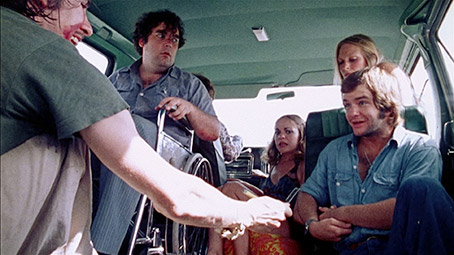
As they group departs at speed, it's once again the realistic nature of Kirk's reaction that always strikes me, his dismayed disbelief at what they have just been through being perfectly captured by William Vail's lowered head and shaken demeanour. It's this sense of realism that helps to distance the young protagonists of this film from the multitude of personality-bypass kill fodder that made it easier to identify with the killer over the victim in so many of the late 70s and 80s slasher movies that followed. We don't really get to know them on more than a superficial level, but they're oddly likeable nonetheless, and when they're threatened we genuinely fear for their safety. And fear plays a substantial role in The Texas Chain Saw Massacre.
The unexpected exception in the rapid likeability stakes is the hapless Franklin. Traditionally, saddling one of your lead characters with a disability is a lazy shortcut to instant character empathy, but Hooper here seems to be deliberately kicking against convention by making Franklin the single most annoying person in the film, one whose whiney complaints about just about everything and seeming insensitivity to the feelings of others make it all too easy to appreciate why his companions find him so irritating. Actor Paul A. Partain went the extra mile here, apparently staying in character even between takes to the point where his fellow actors were driven to distraction. That Hooper kept him apart from the others until filming began only added to his status as an outsider who has been reluctantly accepted into an otherwise harmonious group.
It's when the van pulls up at a run-down gas station that three retrospectively interesting things occur. Now if you don't know the film and ignored my warning at the top of this piece, here is where you're going to walk into serious spoiler territory. Just so you know. It's at this point that the group first encounter the character referred to variously as Old Man or The Cook, wonderfully played by a just slightly seedy Jim Siedow. He runs the gas station and is later revealed to be the nominal patriarch of the murderous Sawyer family. Yet what does he do when these kids ask him if he knows the way to the old Franklin house? He tries to warn them off, to steer them away from a location that might put them within dangerous reach of his psychotic brothers. At this point in the film, he's almost a good guy. Or is he? It's equally likely that he warns them off purely out of concern that they might stumble across evidence of his brothers' previous foul play and expose the family's dark secret. This also functions as misdirection, of course, to paint him as harmless in order to bring him back later as a potential saviour and then hit us with the revelation about who he really is.
The second point of interest is the gas station Window Washer (only a handful of the film's characters have credited names). He has no lines, and when the Old Man ambles over to the van to inform the kids that he has no fuel, the Window Washer silently sets about his work. If this were all there was to it, we probably wouldn't even remember he was in the scene at all, but it's not. Seemingly on telepathic autopilot, he immediately stops work when the Old Man walks away from the van, then picks up where he left off when his hesitant boss pauses and responds to the enquiry about the location of the house. And it's a funny moment. Hooper has repeatedly bemoaned the fact that few seem to have appreciated what he regards as the film's black humour. Frankly I'm not surprised, as a couple of darkly funny moments in sea of sheer terror do not by any stretch a black comedy make. But the moments are there, and this is the first. The most famous one comes later, a line of dialogue delivered by the Old Man that everyone who knows the film will be able to quote with little or no prompting.
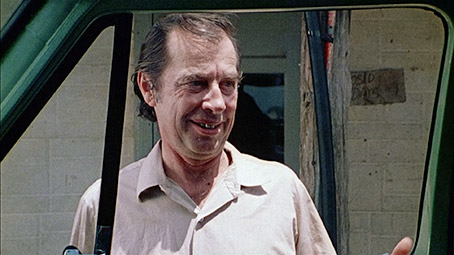
The third thing about this scene is a small and probably insignificant one, and one of only two things in the film that had me scratching my head (the other is more significant and I'll get to that soon). Sally and Franklin's surname is Hardesty, we know that from that opening text and narration. We can presume, I think, that this was also their father's surname. So why, I always wondered, do they ask for directions not to the old Hardesty house, but the old Franklin house? What gives? Was Franklin named after the house, perhaps, or maybe his Dad was so proud of his whiney son that he named the house after him? It doesn't matter a hoot in the grand scheme of the film. I was just curious.
The next surprise comes when they reach the old Hardesty (oops, sorry, Franklin) house. It's derelict and decaying, an open invitation for the director to creep out his audience. Except he doesn't, at least not at first. This is the house in which Sally grew up, and for her it's a treasure trove of childhood memories. As she and her friends make their way through this long abandoned building, they fill it with laughter, laughter that for Franklin quickly rings sour. Abandoned by the others and left to make his way through wheelchair-unfriendly debris, he takes to mocking their giggles and blowing furious raspberries in their general direction. It's a supremely childish gesture, but one that unconsciously imitates the demented behaviour of the Hitchhiker after he was ejected from their van. And despite the cheerful banter elsewhere, there are strangely ominous signs: a bristling cluster of daddy long leg spiders in the top corner of a room; a troubling sculpture of bones and feathers arranged in front of a doorway; a dangling mobile made of thin bones positioned above it. Someone's been here. Someone strange.
It's screamingly hot and Kirk and Pam want to go for a swim and head off in search of a water hole that used to be located nearby. All they find is a dried up creek, but Kirk hears a motor chugging away in the distance and figures they could barter with the owner for some fuel. Pam's not that keen, but they make their way to the source of the sound, and way back on that first viewing, here's where I really started to get on edge. Looking back in hindsight, it's easy to see why. Everything is very slightly off-kilter here. Their walk is shot from a discomfortingly low angle and there's something about the loud and aggressively throaty chug of that motor – eventually revealed to be a generator – that feels peculiarly and perhaps illogically sinister. As they approach the house, they pass a tree from which a variety of tattered objects have been hung. My attention was always drawn to one in particular, a pocket watch with a six inch nail banged through the middle. Just why I have always found this so disturbing I could not say for sure, but it provides plenty of fuel for metaphorical reading, as a symbol of the destruction of civilisation by barbarity, or a visual indicator of a timeline that is about to be brought violently to an end. So fascinated was I by this single object that it was several viewings later before I noticed the tattered remains of the tent that sits beneath it, which lends these seemingly random items a potentially dark back story.
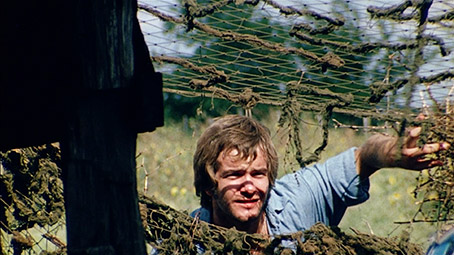
With the generator providing a steady background throb, Kirk discovers a camouflaged collection of old cars (revealed in another sublimely executed dolly shot) and the two approach the house. Kirk bangs on the door and gets no response while Pam sits on the steps, seemingly keen to return to the others. It's here that Hooper's smarts and filmmaking economy are at their keenest. As Kirk steps back from the door, his foot clips something that bounces across the wooden porch with an audible rattle. It's a tooth, an object that serves two distinct and important functions. The first is to unsettle us. It is, after all, a human molar (confirmed by its mercury fillings), and has no place being on someone's front porch. When Kirk jokingly puts in it Pam's hand as a present, it serves its second function, to disgust her enough to send her stomping over to the large swing in the garden to huffily wait for Kirk to conclude his attempts to attract someone's attention. It separates them, and annoys Pam enough to provide a convincing reason why she will not respond to her boyfriend's requests to join him.
When Kirk knocks again, the door swings open to reveal an interior whose walls are peppered with animal skins. There's a doorway at the end of the hall, one that has a shallow ramp leading up to it of the sort you might find at a farm or a slaughterhouse. Hang on a minute... There are noises coming from beyond that door, unidentifiable mechanical sounds, and a pig squealing perhaps? If you weren't tense before this point then you damn well should be now. Kirk calls out again, looks back at Pam, and then edges into the house. Then he does something I have never understood and which constitutes that second head-scratcher I mentioned earlier. Instead of hesitantly walking forward, he starts to run towards the doorway. OK, it's more a trot than a run, but he's suddenly in a big hurry to get into that back room. And I can't for the life of me work out why he does this. It's because of this, of course, that he trips on the ramp and triggers one of the most startling character introductions in horror cinema history. Towering above the fallen Kirkis a monstrous gargoyle in a butcher's apron, one whose is face hidden behind a crudely stitched together and featureless mask. This is Leatherface, one of the most iconic characters in horror film history. There's no aural or visual fanfare to his first appearance – he's just suddenly there, slowly raising a club hammer in a manner that seems to pull the camera up with it. The blow he delivers is unfussily brutal, and the disturbing, skull-fragments-in-the-brain death twitch it triggers is quickly silenced by a second hit. You barely have time to pause for breath before a steel door that seals this section of the house off is pulled aggressively shut, sealing Kirk off from the outside world and providing a bone-chilling punctuation mark to the scene, one that resonates into the shot that follows though the sinister bass drone that echoes in its wake. And given what we have just witnessed, that next shot is about as ominous as they come, a close up of the irritable Pam (shot with a long lens to isolate her from the background) calling Kirk's name. When there is no response, she gets to her feet and walks towards the house in what has become rightly celebrated as one of the most sublimely executed dolly shots in cinema history, as the camera glides under the swing seat and follows Pam as she walks towards a house that appears to grow in size with every step she takes.****
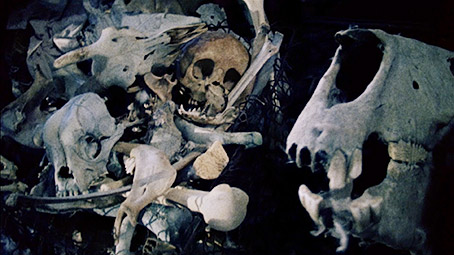
Knowing what we now know colours every hesitant step that Pam takes into the darkened hallway of the house, but even this doesn't prepare us for what she very literally stumbles into. This is a room pulled out of a cannibalistic nightmare, strewn with human and animal bones, some of which have even been fashioned into furniture. The floor is caked with feathers, and there are tools and general debris just about everywhere you look. Yet the single most troubling sight is a fully grown chicken imprisoned in a budgie-sized bird cage, an almost subconscious image of improvised factory farming in a film that a writer in Time Out once described as "Hooper's extreme pro-vegetarianism tract." This room, unknowingly, was to prove a prototype for all future serial killer lairs, and yet remains more startling, more inventively realised and more genuinely disturbing than any of its would-be imitators, a tribute to the warped but brilliant vision of production designer Robert Burns.
It's when Pam attempts to flee that Leatherface reappears, pulling her off her feet just as she escapes the confines of the house and carrying her back inside with all the effort required to transport a small sack of potatoes. Actress Teri McMinn completely sells Pam's predicament here, from the horrible authenticity of her terrified screams to the convincing physical struggle she puts up against the arms that have encircled her body. But she doesn't have a chance. Leatherface is a bulked-up giant of a man, able to snatch her from her feet so violently that it actually pulls her out of her shoes (a detail it's easy to miss on the first viewing). Her fate remains to this day one of the most horrible in horror movie history, as she is hung on a butcher's hook, still conscious and clearly in indescribable pain, while Leatherface takes the chainsaw of the title and methodically begins dismembering Kirk by cutting off his head. As Hooper himself has observed, if the audience is going to walk, this is when it will happen. And yet despite the extraordinary impact of the sequence, none of what happens is shown in graphic detail, nor is a single drop of blood visibly spilled. It's all down the horrifying implications of what we are slyly manipulated into believing we have seen, the appalling nature of what is taking place, and the chillingly convincing suffering of Teri McMinn. Her screams, expression and body language – her eyes are clamped shut, her face contorted in agony and her arms reaching desperately for something she cannot grasp – are not those of a horror movie extra, but (we can thankfully only imagine) someone who is genuinely hanging from a hook that has been driven into her back. You don't just watch this sequence, you feel it.

By the time Gerry heads out in search of the pair, a cloud of doom is hanging over him and his companions, and his walk towards the house is one coloured with dread. Chance really does play a part in his fate here. Had Kirk not left his top on the porch railing, Jerry might have turned back and survived the night. But the top is there and Jerry thus enters the house to investigate. As terrified male reactions go, you'll never see and hear a more convincing one than the look of sheer terror and accompanying high-pitched scream that explodes from actor Allen Danziger when Leatherface appears, the result in no small part of this being the actor's first exposure to Gunnar Hansen in his full Leatherface get-up.
As night falls and Sally struggles to push Franklin through resistant woodland and undergrowth, there's an increasing sense that no-one is going to make it out of there alive. Here Hooper delivers the film's only real old-school, boo-shouting shock moment, as Leatherface leaps out of nowhere into torch-lit close-up, starting his chain saw as he does so for maximum effect. Again Hooper shoots the subsequent carving up of Franklin's stomach from an angle that shows us nothing but whose implications are appalling, focussing our attention on the act rather than a make-up effect.
It's here that the film switches gear and becomes single-minded in its determination to terrorise Sally – and through complete empathy with her plight, the audience – to the point of near insanity. While this was to become standard operating procedure for just about every slasher and torture porn horror to follow, only John Carpenter came close even close to matching the sheer relentless terror of what unfolds here when he set Michael Myers against Laurie Strode in the 1978 Halloween. And yet despite my love of that film and the pant-crapping fear I experienced on my first viewing, even that doesn't hold a candle to the sheer punishing intensity of what Hooper puts us and his leading lady through here.
The chase through the woodland that follows, which at one point continues into and out of the death house, is a spectacular wind-up in itself, and seems to go on for far longer than you would believe it could be maintained. It's astonishingly filmed, with a series of breathless, run-though-the woods dolly shots culminating in a heart-stopping straight to camera run that seems to place Leatherface only a couple of feet behind the fleeing Sally, like an out-of-control juggernaut bearing down on a moped. The soundtrack is crucial here, a stomach-twisting blend of screams and chainsaw roar, an aural assault on the senses that just never lets up.
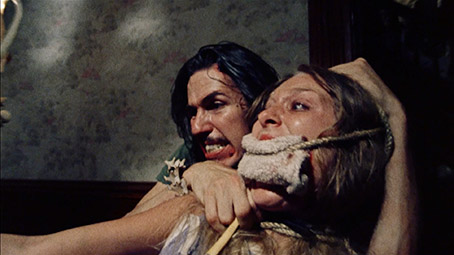
When Sally bursts into the gas station office, the initial explosion of relief is so strong I'm sure that I almost threw up on my first viewing. It doesn't last long. In a particularly unsettling moment, when the Old Man goes off to fetch his truck, Sally's attention is drawn to the barbecue meat cooking in the station's grill, lit red like it's being heated by the fires of hell. Only in retrospect are we given cause to wonder exactly what the source is of the meat on display.
Hooper then twice pulls the rug from beneath the audience's feet by revealing that not only is the Old Man Leatherface's brother, he's also kin to the Hitchhiker, who is just overjoyed to see Sally again. The Old Man's earlier concern for the welfare of these youngsters dissolves when it becomes a family issue – he may not be a killer like his brothers, but still has a gleefully sadistic streak, and it's he who knows best how to process the meat.
The dinner scene that unfolds once the bound and gagged Sally has been transported to the house ("Look what your brother did to the door!") is justifiably famous, as the film becomes a hair-raisingly subjective experience, with Sally's terror vividly externalised through a series of off-kilter camera angles, aggressive edits and extreme close-ups of her petrified eyeballs, accentuated by production design that creates an all-too vivid vision of a home-made hell, from the chair with human arms to the lampshade sewn together from the skin of a human head. Topping it off is a soundtrack in which the experimental chimes, clangs and whines of the score reach a fever pitch, which intermittently dovetails into Sally's persistent screams and pleas. And boy do they stay with you. Never have I heard more convincing screams of utter, complete terror than the ones that Marilyn Burns unleashes here, and never before or since have I watched anyone in a film maintain the level of utterly and completely convincing borderline hysteria than Burns manages for the entire final 30 minutes of this 83 minute film. There's not one single solitary moment when you don't believe what she's going through is absolutely real – even the arm-flailing panic that frees her from the Hitchhiker's clutches is completely authentic, her furious desperation giving her physical strength and energy she didn't even know she had. The look on her face immediately after she has leapt through the window into the grim light of dawn – blood running from a head wound, her mouth stretched wide and her eyes bulging in fear, scanning the land ahead for a route to possible escape – is one of those images that is forever seared into my soul, captured by a camera move that, while subtle and perhaps even unnecessary, just feels perfect for a moment that would somehow not be complete without it.

As the sun rises and Sally limps her way into the back of a pick-up truck that is only just able to outrun the approaching Leatherface, the blood-soaked Burns delivers a blend of near-feverish terror and almost triumphant, hysteria-driven laughter that I would rank among the finest pieces of committed and convincing acting I have ever seen in a film, horror themed or otherwise. At the first screening this left me shattered and shaking and stumbling through London in search of a bar and the strongest drink I could stomach in my delicate state. I've seen the film a good many times since, of course, but watching this one again for the first time in a few years in preparation for this review, I was astonished at how seriously it still managed to shake me up. As has been pointed out many times by others, it's not what you see that makes The Texas Chain Saw Massacre such devastating viewing, but the sheer, unrelenting intensity of the experience. As an all-out horror work it still has no peer – genre enthusiast Stephen Thrower, author of Nightmare USA and Beyond Terror, once memorably described it as "a perfect jewel of a film" – and its influence on later genre works would constitute a major essay in itself, and is visible in everything from Sam Raimi's original The Evil Dead to Ridley Scott's masterful Alien. Indeed, it is Scott, when discussing the influences on Alien, who succinctly and unfussily summed up just why the film has had such an effect on audiences and filmmakers alike:
"I was fully influenced at that moment, mostly by 2001 actually. Oh, and Star Wars. I thought that first Star Wars was formidable. But that was the fairy story, Star Wars was the fairy story. I was going to do The Texas Chain Saw Massacre of science fiction, because I still think Texas is one of the most formidable... if you're going to do a horror movie, there it is."
| A Craven Act |
| An all too vivid recollection of the shame of my first viewing of The Texas Chain Saw Massacre, by Camus |
|
"If I have any more fun today I don't think I'm going to be able to take it!" |
Wheelchair bound, Franklin Hardesty (Paul A. Partain) |
I didn't think I could take it either so I cheated, much to my own personal horror…
Fear never leaves us. It's part of our operating system. We're animals after all, evolved to be scared of creatures and conditions that could take our lives unless we could run faster than they could or protect ourselves. Fear is rational and still required in heavy doses in many cultures where living doesn't involve electricity or reason shouldered against mind-laundered zealots. To have your fear preyed upon by artists and craftspeople, to have it gently but shockingly prised open to leak venom into your calm surface tension while you sit in the dark is a skill few possess. And I'm not talking about relatively easy "Boo!" tactics. That particular fear is irrational (you're sitting in a plush velvet seat being assaulted by sounds and images that cannot possibly harm you physically and you know this). But, holy shit, that irrational fear is bloody terrifying. The reasons why we like to be frightened in a cinema may have a little or a lot to do with the fact that we don't have enough of it in our 'ordinary' lives (given our bodies are still stone age mechanisms evolved to fight or take flight) but there is an attraction that's definitely sensually seductive.
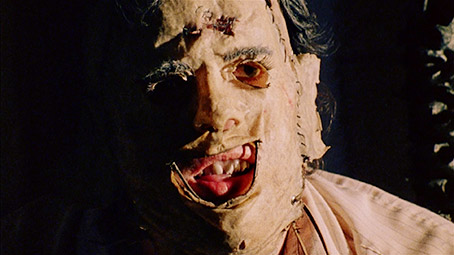
I am experiencing certain but fleeting frissons of genuine fear where I'm living alone at the moment, an old, huge house where a relay of light switches have to go on as you leave the dark behind you and move into the light. More than one bulb has blown along the way. I swear I'd have instantaneous heart failure if I saw a woman in a long dress pass by one of the corridors a la The Innocents, never mind Leatherface himself popping out from one of the many rooms I have to pass to get to my own. The subtle art of fear mongering (and it is subtle) is so far removed from the gross dross that's inveigled into the once proud horror genre. A sustained horror scene from Robert Wise's superb The Haunting (1963) could trump any body horror made today – and that was just the sound of something smashing on the walls. Where's the intelligence, the ambience, the wit? So our fear's still there but never was it more concentrated in my early cinema going after reading about a film with the Snakes On A Plane 'tell it like it is' title of The Texas Chain Saw Massacre.
My experience was in the early 80s and horror had a long way to go to reach the unfathomable successes of successive Saw entries. The idea of seeing anyone killed by a chain saw was appalling to me (re-read that please, appalling, not appealing) but… how would they do it? They couldn't actually show it, could they? I was, of course, mired in old school special effects enthusiasm so said to myself, when the time was right, I'd see it. It lodged in the 'Fright Factory' part of my psyche for many years before I actually got to see it (unheard of today). The IMDB doesn't list independent release dates but I was certain I'd seen it before the 80s got action-crazy. Its own website proclaims it was banned in the UK for 25 years but surely that's not true – I saw it in a cinema (well sort of, read on) in the early 80s. The last time I was truly unnerved in a cinema was in 1979 in Santa Barbara being gleefully watched by my cinema going friend (who'd seen it before) as John Hurt tucked in to some noodles. Scott's Alien imagery bored into my cerebellum and camped out for what seemed like months. Vestiges of those acid dripping tent pegs and compromised flysheet still remain. In fact I'm sitting at work (having finished the day's duties I might add) wearing a Nostromo T shirt as I type.
I can remember the first time too – that experience came courtesy of a certain Alfred Hitchcock and the eyeless farmer triptych of cuts (all achieved in virtual silence). Standing in the middle of these two formative fear events like a big-top pole of terror is a film that I truly regard with some genuine awe. I'm not caving in to any recent 'best of' lists (four years ago Total Film polled horror film-makers and sitting at No. 1 was The Texas Chain Saw Massacre – good for them) but it is a film quite like no other. I'll leave the actual review and fascinating cultural analyses to my fellow scribe. I just want to share one of the most craven acts of cinematic cowardice with you to give you the full flavour of what the advance word on this movie did to me.
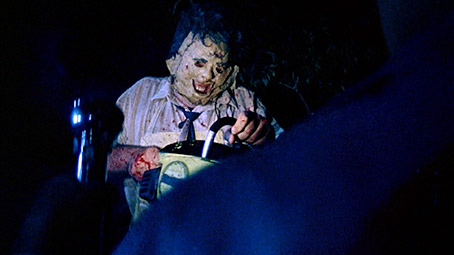
There was nowhere, unlike today, that I could go to find out what was actually in the movie. I reasoned a chain saw had to be involved but that was about it. The fact remained that I was literally too scared to see it. It was like the media frenzy had placed it apart – this was something special, beyond the limits of horror, way past any acceptable form of movie I'd yet seen. It had been with me, the idea of what it might be, for years. Do you know how many barnacles can form on a rock if you leave it in the sea for long enough? I could no longer imagine the rock. All I had were the barnacles – nightmarish images of all sorts of terrifying events that I was responsible for, the spurts of my Vesuvian subconscious. In short I'd worked myself into an almost psychotic dread of ever seeing the damn thing because of an over-active and morbid imagination.
Impasse.
I had to see it and I had to give in to my fear of seeing it. Impossible. So I found a way (I'm not proud). Drum roll for the wimpy kid… I watched it from the projection booth courtesy of an amenable projectionist. I know, I know, I'm sorry but I've never had such conflicting feelings about any film before or since. I had the alternate heat and rattling from the each of the two projectors either side of me (suitably Texan summer conditions); cigarette smoke wreathed the room like skeletal phantoms on the wing; the big screen (in front of which the brave people sat) was smaller than a TV screen viewed from behind a glass square (supposedly soundproof but they never were). I was isolated enough for the rank horror not to get to me but not so much that I didn't totally engage in the movie. I was terrified (it is an extraordinary film) yes, but there was something more. There are beats in any horror movie that are expected but this film, from the moment the first and only chainsaw murder occurs, started a relentless chain of events of such intensity that even though there is very little actual gore, the ride was both unbelievably scary and purely as a cinematic experience, exhilarating. Now exhilarating needn't have a positive meaning (I didn't actually enjoy it if I can still say that with any credibility) but I recognised its raw power. No movie since that I've seen has successfully kept my nerves on such a knife edge for such a long period of movie time.
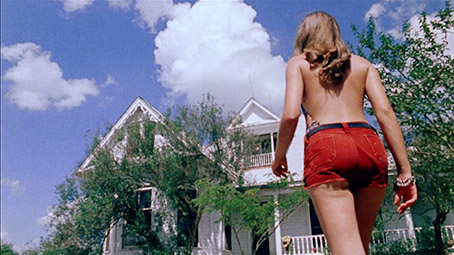
In hindsight, remembering how Hooper moved his camera (eschewing hand held throughout I seem to remember but I might be wrong), his choice of angles, his subtlety in staging the violence, there's still one aspect that's under appreciated of this seminal work; the acting. I'll stand up for that. Marilyn Burns is unerringly convincing as the family's victim. If she'd been one degree higher her performance may have tipped but it just felt absolutely pitch-perfect. Hysteria, sustained hysteria is bloody difficult to pull off. How much more could this poor girl take? How can she still have anything left of her larynx to scream like that? Also worth a nod is the creepy and utterly demented hitchhiker brother played by Edwin Neal. He is so perfectly cast and inhabits the role so well, there's never a false note, even in his own hysterics. The strength of the movie is its (dare I say) believability… it is utterly convincing and that's also where part of its great power resides. As Sally is driven away, blood soaked, screaming and laughing concurrently, I thought even then "That's about a million bucks of analyst fees, right there."
That kind of experience – and my answer to seeing something I desperately didn't want to see – is not likely to happen again to me in this part of the 21st century but let me assure you, at the time the terror was real even if the story wasn't true.
This transfer has been taken from a new 4K restoration of the film, but I wouldn't go expecting the sort of eye-popping glories you'll find on the BFI's simultaneously released Blu-ray of the fabulously restored The Day the Earth Caught Fire. The Texas Chain Saw Massacre was shot on 16mm reversal stock and then blown up to 35mm and cropped from 1.33:1 to 1.85:1, or in the case of the transfer here, 1.78:1, which prevents the image from ever boasting the sort of sharpness that you'll find on films shot on fine grain 35mm stock. The film has always looked gritty and that's still very much reflected in this new restoration. Within these restrictions the detail is very good, the image is always clean and the contrast, though a little aggressive in places, is generally good. The film grain has always been visible, but never more so than it is here. A side-by-side comparison with Second Sight's previous, somewhat optimistically titled 'Seriously Ultimate Edition' and the Blu-ray release highlights the differences in this new transfer – the grain is more sharply rendered, but the colours occasionally feel a little truer and the picture detail does intermittently feel a little clearer. The upgrade is not huge, but is definitely visible.
It should be noted that the screen grabs included with this review are from that earlier Blu-ray release – the enhanced copy protection on the new disc made it impossible for us to get screen grabs from the disc at this time (if this should change with the next software upgrade I will replace the grabs with equivalents from the new edition).
There are four soundtrack options – Linear PCM 2.0 mono, Linear PCM 2.0 stereo, DTS-HD Master Audio 5.1 surround, and DTS-HD Master Audio 7.1 surround. The mono track is the truest to how the film originally played, and is clearly recorded and mixed. The stereo track isn't big on directional sound for effects and dialogue, but does have audible separation in the music, though is noticeably quieter than the mono track (just turn the volume up a bit on the amp). The 5.1 and 7.1 DTS-HD tracks have clearly been remixed and have a fuller and richer feel, with the music once again seemingly benefiting the most. That said, the difference in sound quality between the music and effects and the dialogue is a lot more stark as a result, and the final chainsaw swinging has been given a serious volume boost.
Disc 1
Commentary with Writer-Producer-Director Tobe Hooper, Cinematographer Daniel Pearl, Actor Gunnar Hansen
A port of the commentary first recorded for the Elite Entertainment DVD release, this is still a welcome and consistently enthralling inclusion. The film's original titles both get a mention (Hansen was all for Leatherface, but there are few votes for Headcheese), and there's detailed discussion on the film stock used, the procurement of bones and carcasses for the shoot, shooting the night-time woodland chase, the punishment suffered by Marilyn Burns, the effect on everyone of shooting for 27 hours straight on the nightmare dinner scene, and a good deal more. It was here that I first learned that Hooper had kept certain actors apart from each other until they had to shoot their scenes together, hence the ability of Paul Partain (Franklin) to irritate the hell out of his fellow cast members and Allen Danziger's utterly authentic scream of horror when first being confronted by Gunnar Hansen as Leatherface.
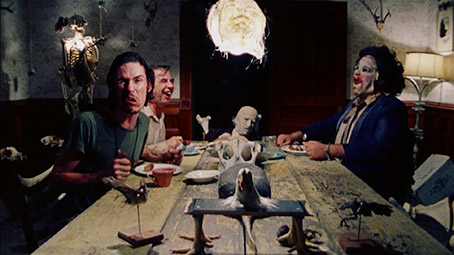
Commentary with Actors Marilyn Burns, Allen Danziger and Paul A. Partain and Art Director Robert Burns
A second import from the earlier DVD release and equally welcome, this lively commentary is moderated by David Gregory, director of the documentary The Shocking Truth, which is included on this release and is detailed below. Each of the participants have their own stories to tell: Robert Burns provides details on the set dressing of specific locations and reveals that some of the bone furniture was later exhibited; Allen Danziger recalls his character's demise and that Edwin Neal was actually fun to hang out with after they had filmed his scenes; Marilyn Burns remembers being thoroughly pissed off at Paul Partain during their night time bickering scene ("I was ready to kill you") and admits that until recently she was under the impression that the cut made to her finger by Gunnar Hansen during the dinner scene was accidental; and Paul Partain tells a story about fans blowing raspberries at him at a convention in emulation of his character, and reveals that he was only persuaded to do that run down the hill in his wheelchair when Hooper agreed to try it out first and that he had so much fun that everyone wanted to have a go. No-one has a good word to say for the 2003 remake, and towards the end they make a brief phone call to an excitable Edwin Neal, who appears to be having the time of his life at a fan convention.
Commentary with Writer-Producer-Director Tobe Hooper
A new commentary track with Tobe Hooper, who is joined this time around and effectively prompted by David Gregory. Surprisingly, perhaps, there is little crossover with his previous commentary, and what is revisited is covered from a different angle than before. Hooper takes this opportunity to highlight aspects of the film's production that he didn't feel he gave a fair shake to the first time around, particularly the help given to him by Buzz Knudson, the head sound mixer at Todd-AO, who had to mix the soundtrack twice when a fundamental error made by the negative cutters required Hooper to shorten almost every shot in the film by a single frame. Hooper also provided me with one of those "oh, of course!" moments with the suggestion that there's a Bogart quality to Jim Siedow's appearance, and pays tribute to production designer Robert Burns' fastidiousness (he had even set dressed the inside of drawers that would never be opened). He also reveals that two of the key influences on the tone of the film were A Clockwork Orange and John Frankenheimer's Seconds. There's some fascinating info on how the avant-garde music track was created, and Hooper admits that he only learned the truth about the cutting of Marilyn Burns' finger in the dinner scene a couple of years ago, which seems a little suspect given that this was discussed by Gunnar Hansen in their earlier commentary together. Great stuff, nonetheless, and the above is just a sampling of the areas covered here.
Commentary with Cinematographer Daniel Pearl, Editor Larry J. Carroll, Sound Recordist Ted Nicolaou
Again moderated by David Gregory, the second of the new commentaries may well be the best of the lot. It probably helps that the three contributors here were at film school together and thus knew each other even before they were hired to work on Texas Chain Saw, but all are great storytellers and have very distinct memories of the shoot itself, and discussion about their early work and how they came to the project gives way to a string of engaging tales. One of my favourites concerns the camera loaned from University of Texas, which was taken away from them just a week into the production after the money men shut them down because it was felt they were just making it up as they went along. But having worked as a teaching assistant at one point, Pearl still had a set of keys for the department and simply went in one day and took the camera back. Other areas covered include Ed Neil's performance ("It's not all acting with him"), shooting in a moving van in available light, the amount of light required for 25 ASA reversal stock film (sixteen times what we'd need today for the same scene), how comments about the direction written on Nicolaou's detailed notes landed him in trouble with Hooper, the bone hunts of Robert Burns and the sculptures he made with them, the famous swing shot, the 27-hour day, the 'laced brownies' incident (you'll have to listen to learn more), and...oh, there's just tons more here – my notes alone go on for two pages. A terrific companion to the film.
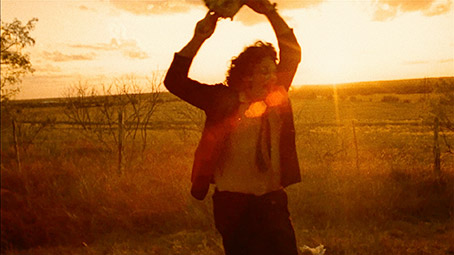
Disc 2
Cutting Chain Saw with Editor J. Larry Carroll (10:41)
The film's editor talks about how he came to the project, how fortunate they were to get such a great cast, how in the absence of a script supervisor, sound recordist Ted Nicolaou's detailed notes proved a life-saver at the editing stage, the process of cutting the film and how having done so has proved a useful calling card for later work. He suggests that Hooper was a vampire due to his nocturnal working schedule, and that the director might have had a more interesting career had he stuck to low budget guerrilla filmmaking and not gone to Hollywood.
Granpaw's Tales with Actor John Dugan (15:48)
Actor John Dugan, who as all of the film's fans know was just 21 when he played Grandpa, talks about how he got the job, working with plastic surgeon and makeup designer Dr. W.E. Barnes, and the process of having the old man make-up applied. He describes Robert Burns as "a fucking genius" and suggests that Burns' rows with Hooper during the shoot were "legendary". He's actually moved to tears by the memory of what Marilyn Burns went through for the film, but still has fond memories of its making. "We complain about how hard it was," he says cheerfully, "but always with smiles on our faces."
Horror's Hallowed Grounds (20:21)
An episode (the second, as it happens) of the do-it-yourself horror fan show from 2008, presented and directed by an almost abrasively enthusiastic Sean Clark. Following a cod-comic version of the film's opening text scroll and narration, Clark visits a number of the locations used in the film and meets up with Tim Harden – who is president of the Official Texas Chain Saw Massacre Fan Club – for a tour of the Sawyer house (this is not the last time you'll see this in the extras), which has since been moved from Williamson County to Kingsland and transformed into a hotel/restaurant. Not without its charm, the programme was shot on mini-DV in the 16:9 aspect ratio, which has been preserved here by windowboxing the image on all sides.
New Deleted Scenes and Outtakes (15:07)
An addition to the previously released collection of outtakes, which have also been included and are detailed below. Seeing these delivers a bit of a jolt, as in some ways the image quality is superior to that of the feature itself – the contrast, though lacking in punch, is considerably more generous in its detail in shadow areas, and the grain is much finer, which at times actually makes the image look sharper. However, it's worth remembering that while shot on low speed 16mmm reversal stock, the film itself was then blown up to 35mm and matted to 1.85:1 for distribution, and that the increase in grain is likely a result of this process. The material here appears to have been carefully scanned from the original 16mm reversal footage (it is framed 1.33:1, the correct, pre-matted aspect ratio for 16mm) and has probably not been graded, and is thus in a 'purer' state. The material included is certainly of interest, consisting largely of alternative angles on existing sequences, and does show what happened to Leatherface after the fleeing Sally bursts through the door of the gas station.
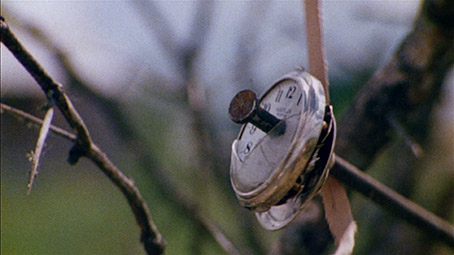
The Shocking Truth (72:48)
A documentary on the film produced and directed by David Gregory in 2000 that has been featured on more than one disc release of the film since. Although not of HD quality and a touch ragged is its structure, the material gathered here is invaluable for devotees of the film. Almost all of the key contributors to the film are interviewed (at this time, only Teri McMinn was unwilling to discuss her involvement) and a good many of the stories you'll find recalled in the commentary are also discussed here, including the influence of the crimes of Ed Gein, the casting, the design of the bone furniture, the decision to hide Leatherface from the rest of the cast until the scenes in which they are confronted by him, the arduous 27-hour day, the final scene reshoot and a whole lot more. The social and cinematic scene is set for the film's production, and some fascinating background is provided on production company Bryanston, which at the time apparently had Mafia connections and effectively cheated the cast and crew out of their percentage of the film's considerable profits. There is also some coverage of the film's three sequels (the third of which starred the then relatively unknown Matthew McConaughey and Renée Zellweger), and Gunnar Hansen is on hand to give us another tour of the restaurant that doubled as the Sawyer house.
The Shocking Truth Outtakes (7:41)
Snippets of interviews that didn't make their way into the final cut of the documentary. Most (though not all) of the stories told here can be found on the other extra features, but these are still of interest.
Flesh Wounds – Seven Stories of the Saw (71:43)
Shot in 2006 and directed and edited by Michael R. Flesher, this substantial, seven-part piece sets out to fill in the gaps left by previous documentaries on the maiing of Texas Chain Saw. Well, it does and it doesn't, but there's still plenty of interest here for just about anyone with an interest in the film. It starts a little shakily with an interview with cinematographer Daniel Pearl, and while he's always interesting, much of what he tells us has been covered elsewhere, which probably counts as strike one against the film's intended brief. An unrelated strike two comes in the form of some infuriating post-production tinkering of the sort that was popular for a while with documentary directors trying to get themselves noticed, with the image changing from colour to grainy black-and-white and then cropped into scope, then the sound is tweaked to make the recollection of phone call sound like it's being delivered through a telephone handset, and so on. It had me screaming "Just let the man talk, for fuck's sake!" at the TV. I'm tempted to award strike 3 against the second part – in which TCM Fan Club president Tim Harden takes us on a tour of the Sawyer house – as although this was made two years before the Horror's Hallowed Grounds piece that features the self same thing, it was also six years after Gunnar Hansen did likewise in The Shocking Truth. Things pick up after this, though, with a welcome interview with Edwin Neal, whose twitchy excitability and talent for funny voices makes him seem at times like a live-action cartoon. A brief but sincere tribute to the contributors who have since passed away – Jim Siedow, Paul Partain and Robert Burns – is followed by an interview with plastic surgeon Dr. W.E. Barnes, who talks about creating the old man make-up for the Grandfather, and by a look at two of the more local horror conventions at which the film has been honoured and screened. It concludes with a most enjoyable interview with a cheery Gunnar Hansen, who frankly looks like he'd be enormous fun to spend the day with in any circumstances. Of course, what's really missing here is...
Off the Hook with Teri McMinn (17:02)
Unwilling to discuss the film for a good many years (she declined to participate in The Shocking Truth), apparently because she was unhappy about the way the celebrated beneath-the-swing shot seemed to focus on her behind, she has more recently embraced the film (and that shot, as it happens) and is apparently having a ball at conventions, interacting with the fans ("they are so cute!") and meeting up again with her former co-stars. And yes, she does talk about her work on the film in the hoped-for detail.
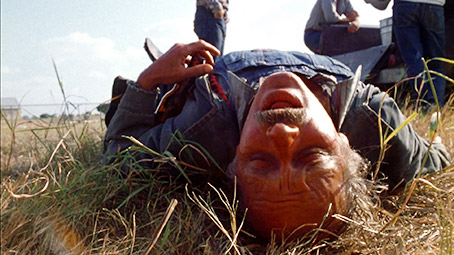
The Business of Chain Saw with Production Manager Ron Bozman (16:25)
The film's production manager recalls first meeting Tobe Hooper and Kim Henkel on the 1971 feature The Windsplitter, on which Bozman and Henkel were grips and Hooper was one of the actors (for real!), along with, as it happens, a certain Jim Siedow. A couple of good stories from elsewhere are related from a different angle here, notably Bozman's dealings with the mob-connected production company Bryanston (whose head honcho was named Anthony "Big Tony" Peraino – talk about hiding in plain sight), and his terror at the prospect of the local sheriff he had innocently invited to visit the set discovering that there was a field full of marijuana being gown out back. He also reveals that, as a producer, he hadn't planned to ever revisit a film with this sort of subject matter ever again, but relented for regular collaborator Jonathan Demme and ended up collecting an Oscar for The Silence of the Lambs.
House Tour With Gunnar Hansen (8:04)
Now here's a novelty... OK, this one does briefly differ from its companions elsewhere on this release through the inclusion of some footage shot in 1993 at the house in its original location, derelict and legally off-limits to the filmmakers. But otherwise it's very much a case of been there, seen that.
Tobe Hooper Interview (13:46)
Given the framing and the familiar-looking background, this would appear to have been shot by David Gregory and his team for The Shocking Truth. As interesting as ever, Hooper reflects on the influence on the film of the Texas he grew up in, provides character breakdowns for the Hitchhiker and the Cook, and talks about set dressing the house, shooting the chase in a small space of woodland, the importance of ending the film as the sun rises, the sound mix, and the film's reception and subsequent success.
Kim Henkel Interview (8:25)
The film's co-writer and associate producer Kim Henkel talks in some detail about how the activities of serial killer Elmer Wayne Henley helped to shape the screenplay, his attempt to revive the spirit of the original with the 1994 Texas Chainsaw Massacre: The Next Generation), and the advantages of making the original outside of the studio system. This again looks as though it was shot for The Shocking Truth.
Deleted Scenes and Outtakes (25:23)
A solid collection of deleted material, albeit one that has already made the rounds on previous home video releases. Included is some unused material from the opening grave-robbing sequence, the original introduction of the camper van, the discovery of the abandoned tent, Leatherface applying face powder and makeup (kind of glad this was cut), and a collection of wide-angle wanders over Robert Burns' bone sculptures set to the echoing clangs and crashes of the score. The quality of the image does vary, but is generally better than I remember from its DVD incarnation.
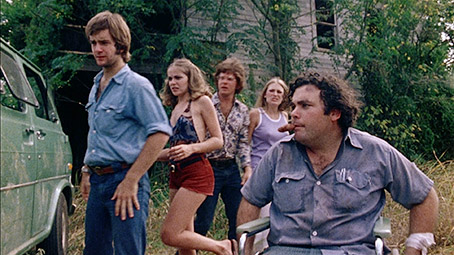
Bloopers (2:23)
A few tension-busting bloopers, a mix of fluffed lines and physical misfortune, including the twice recalled splashing of Jim Siedow by the Window Washer. The quality is not great on some of these.
Trailers and TV Spots (6:33)
A trailer for this new 4K restoration, plus two of the original trailers (which are peppered with spoilers) and two TV spots.
Radio Spots (1:03)
Two of the original radio spots.
Stills Gallery (2:36)
A rolling gallery of production stills, posters, and a couple of montages in a wide variety of conditions.
As you've probably guessed, I'm with Stephen Thrower on this one. The Texas Chain Saw Massacre (and this is the only film under that banner where 'Chainsaw' is written as two separate words) was one of the films that defined my teenage years, one of the few that have scared me shitless, and the standard by which I still judge other genre films to this day. They rarely match up. As far as I am concerned, it's a dyed-in-the-wool masterpiece, a boldly conceived, brilliantly executed and magnificently performed game-changer that deserves every plaudit it has attracted since its initial release. Having overstated the case a little with their previous 'Seriously Ultimate Edition', Second Sight seem to have delivered on that promise this time around, with a strong transfer, four soundtrack options, and just about every extra feature from previous releases plus a few choice new ones. Seriously, if there's anything you don't know about the film after watching everything on the two discs included here, then it's probably not worth knowing. Very highly recommended.
* Nigel Andrews, Financial Times, 19th November 1976
** 'The Ferman Chainsaw Massacre...' http://www.melonfarmers.co.uk/arbptcm.htm
*** In a cameo that likely flies over most people's heads, the old man with the pipe and the winning smile in this sequence is played by John Henry Faulk, a radio show host who fell victim to the Hollywood blacklist in the 1950s, a practice he helped to bring about the demise of when he successfully sued the organisation behind it. He wrote about the experience in some detail in his 1963 book, Fear on Trial, which in 1975 was adapted by screenwriter David W. Rintels into an Emmy award winning TV movie directed by Lamont Johnson and starring William Devane as Faulk and George C. Scott as his lawyer Louis Nizer.
**** A little ironic that what has become one of the most celebrated shots in the film was thought up on the spot by cinematographer Daniel Pearl, and was nearly brought to a halt when the producers insisted that it could not be filmed because it wasn't on the shot list. Hooper's proclamation that they could fire him but couldn't prevent him from getting this shot thankfully prevailed.
|